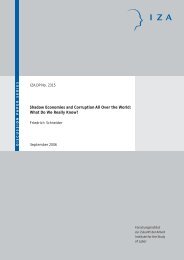Minimum Wages in Kenya Mabel Andalón - Index of - IZA
Minimum Wages in Kenya Mabel Andalón - Index of - IZA
Minimum Wages in Kenya Mabel Andalón - Index of - IZA
Create successful ePaper yourself
Turn your PDF publications into a flip-book with our unique Google optimized e-Paper software.
I. Introduction<br />
Policies to set ―liv<strong>in</strong>g wages‖ are a popular but contentious <strong>in</strong>strument. As Blanchard<br />
(2002) suggests, the ma<strong>in</strong> reason for <strong>in</strong>stitut<strong>in</strong>g m<strong>in</strong>imum wages is to empower workers<br />
whose wages are constra<strong>in</strong>ed by the excessive market power <strong>of</strong> employers. Two other<br />
arguments <strong>in</strong> favor <strong>of</strong> m<strong>in</strong>imum wage sett<strong>in</strong>g relate to efficiency-wages and the fact that<br />
m<strong>in</strong>imum wages <strong>in</strong>crease workers’ purchas<strong>in</strong>g power, which <strong>in</strong> turn can stimulate labor<br />
demand (Lev<strong>in</strong>-Waldman, 1997). The efficiency-wage argument states that higher wages<br />
can <strong>in</strong>crease workers’ productivity, which <strong>in</strong> turn allows employers to pay higher wages.<br />
One reason for an <strong>in</strong>crease <strong>in</strong> productivity might be that higher wages allow workers to<br />
improve their nutrition and their human development. Another version <strong>of</strong> this argument<br />
is that m<strong>in</strong>imum wages force managers to provide on-the-job tra<strong>in</strong><strong>in</strong>g, which makes<br />
workers more productive. Yet, it may be also argued that <strong>in</strong> the absence <strong>of</strong> well<br />
developed <strong>in</strong>centives to provide tra<strong>in</strong><strong>in</strong>g, firms may just become more selective, hir<strong>in</strong>g<br />
workers with higher productivity rather than <strong>in</strong>curr<strong>in</strong>g <strong>in</strong> the cost <strong>of</strong> tra<strong>in</strong><strong>in</strong>g them. On its<br />
part, the purchas<strong>in</strong>g power argument requires that low wage bus<strong>in</strong>ess benefit from the<br />
higher consumption <strong>of</strong> low-<strong>in</strong>come workers, which may not necessarily be the case. In<br />
absence <strong>of</strong> that l<strong>in</strong>k the effects are likely to be small, as <strong>in</strong>creased sales are not likely to<br />
compensate for higher wage costs.<br />
<strong>M<strong>in</strong>imum</strong> wages might also help lift the work<strong>in</strong>g poor out <strong>of</strong> poverty by rais<strong>in</strong>g their<br />
wages. The empirical literature <strong>in</strong> Lat<strong>in</strong> America (Morley, 1995) and other develop<strong>in</strong>g<br />
countries (Lustig and Mcleod, 1997) provides evidence that poverty falls as the m<strong>in</strong>imum<br />
wage rises. However, a theoretical model developed by Fields and Kanbur (2007)<br />
suggests that poverty can actually decrease, <strong>in</strong>crease or rema<strong>in</strong> unchanged depend<strong>in</strong>g on<br />
the degree <strong>of</strong> poverty aversion, the elasticity <strong>of</strong> labor demand, the ratio <strong>of</strong> the m<strong>in</strong>imum<br />
wage to the poverty l<strong>in</strong>e, and the extent <strong>of</strong> <strong>in</strong>come shar<strong>in</strong>g.<br />
Yet, despite its potential benefits, m<strong>in</strong>imum wages might also br<strong>in</strong>g undesirable side<br />
effects. The standard competitive model predicts that forc<strong>in</strong>g the price <strong>of</strong> labor above the<br />
market price leads to job losses <strong>in</strong> firms where regulations are enforced, and an <strong>in</strong>crease<br />
2
















